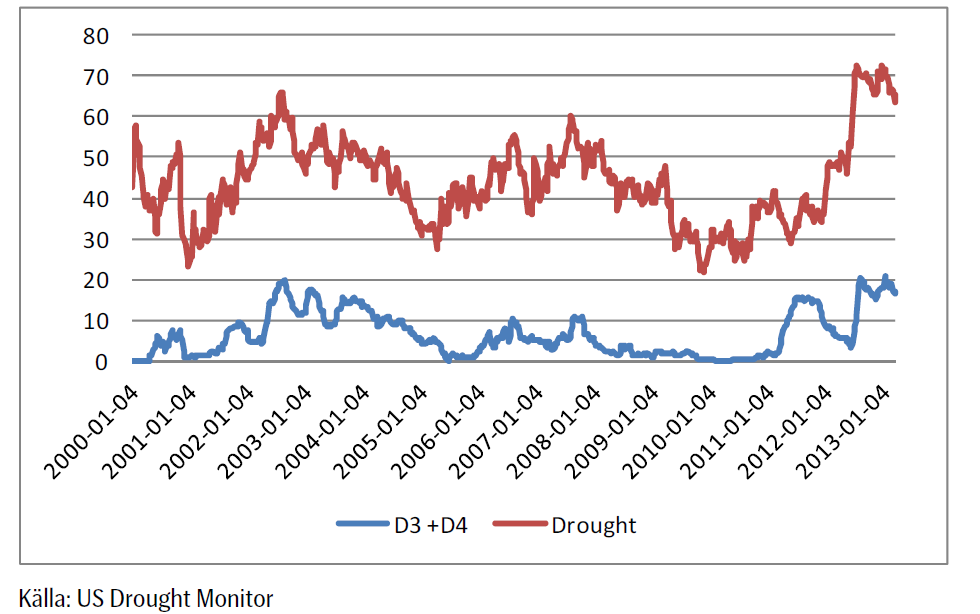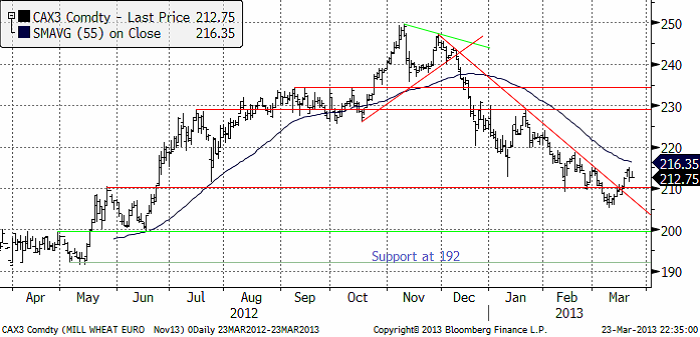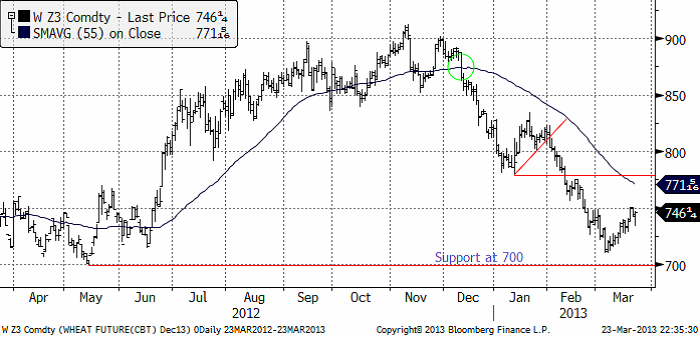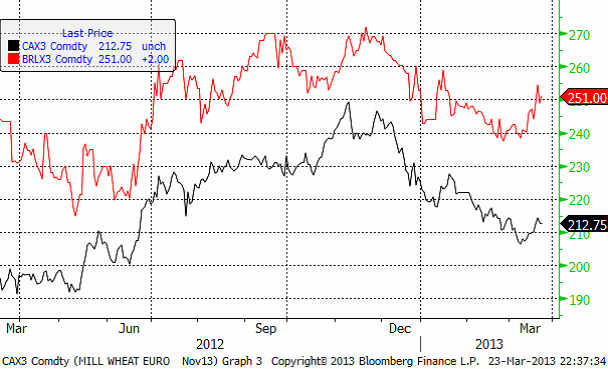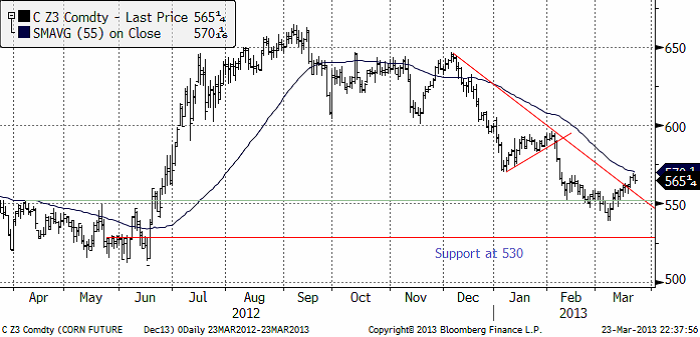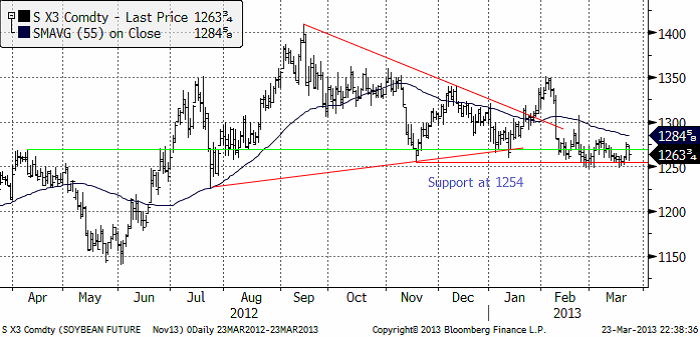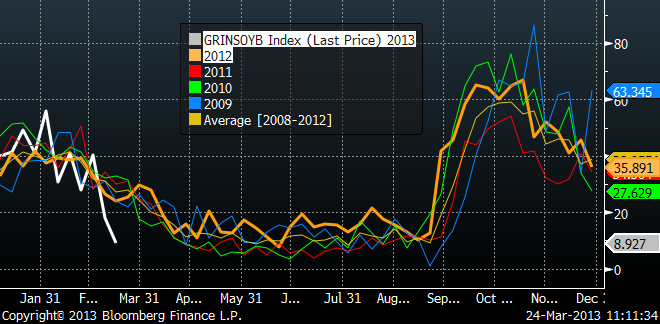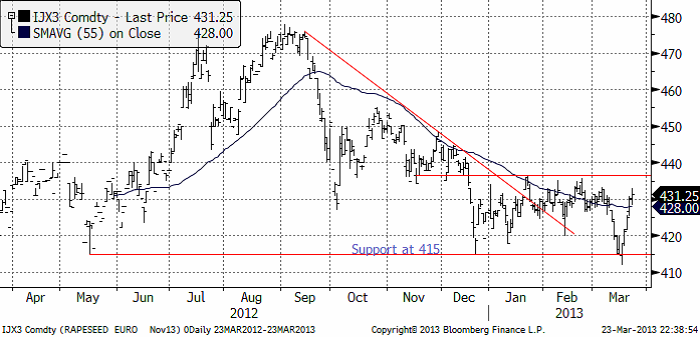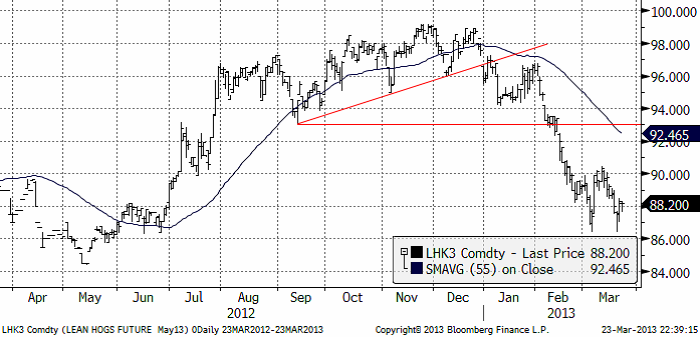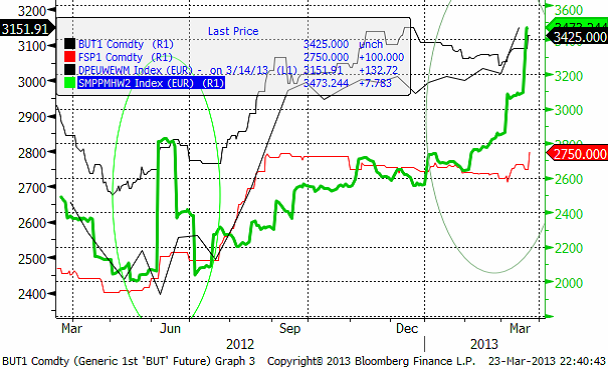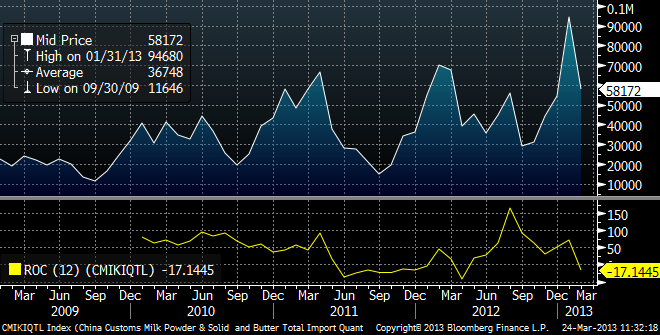Analys
SEB Jordbruksprodukter, 25 mars 2013

 Förra veckans handel i jordbruksprodukterna påverkades endast ytligt av svallvågorna från Cypernkrisen. Priserna steg överlag på nästan alla marknader. Starkast gick vete. Jag tror att det huvudsakligen handlar om att priset fallit lite för långt ner på allt för tidigt inkasserade förhoppningar om regn i USA. Torkan i USA registrerades som något värre förra veckan än veckan innan. Europa oroar sig förvånande lite över de extremt låga utgående lager som t ex USDA har för EU-27. Lagerstatistiken som USDA publicerar på torsdag den 28 mars kan skapa en hel del volatilitet. Klockan 17 presenteras uppdaterade siffror på ”prospective plantings” för vete och majs och lagerstatistiken per den första mars.
Förra veckans handel i jordbruksprodukterna påverkades endast ytligt av svallvågorna från Cypernkrisen. Priserna steg överlag på nästan alla marknader. Starkast gick vete. Jag tror att det huvudsakligen handlar om att priset fallit lite för långt ner på allt för tidigt inkasserade förhoppningar om regn i USA. Torkan i USA registrerades som något värre förra veckan än veckan innan. Europa oroar sig förvånande lite över de extremt låga utgående lager som t ex USDA har för EU-27. Lagerstatistiken som USDA publicerar på torsdag den 28 mars kan skapa en hel del volatilitet. Klockan 17 presenteras uppdaterade siffror på ”prospective plantings” för vete och majs och lagerstatistiken per den första mars.
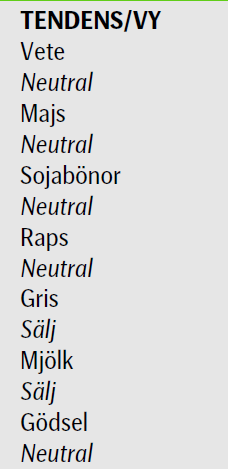 Veckans Fonterra-auktion visade priser som återigen ligger rejält mycket högre än förra auktionen. Priserna på Eurex reagerade med att stiga lite grand. Pressen försöker i vanlig ordning hitta på en ”story” bakom prisuppgången. Bland annat nämns torkan i Nya Zealand (som egentligen till stor del är historia) och kinas glupande aptit på SMP (som också hör till förra året). Februaris import jämfört med samma månad förra året visar på en 17%-ig minskning).
Veckans Fonterra-auktion visade priser som återigen ligger rejält mycket högre än förra auktionen. Priserna på Eurex reagerade med att stiga lite grand. Pressen försöker i vanlig ordning hitta på en ”story” bakom prisuppgången. Bland annat nämns torkan i Nya Zealand (som egentligen till stor del är historia) och kinas glupande aptit på SMP (som också hör till förra året). Februaris import jämfört med samma månad förra året visar på en 17%-ig minskning).
Fram till torsdag väntar vi oss inte några stora kursrörelser. Folk kommer att trimma sina positioner för att inte drabbas av slumpen när lagerstatistiken publiceras på torsdag. Oron är att lagren ska visa sig mindre än väntat. Så har det varit 8 av 10 gånger de senaste åren. Det innebär i sig att risk/reward talar för en prisnedgång på rapportsiffrorna, allt annat lika.
Odlingsväder
US Drought Monitor visar återigen mer av USA drabbat av torka. Den 19 mars var 65% av ytan drabbad av torka. Veckan innan var det 63.7%. Extrem och exceptionell torka ökade till 16.85% av ytan från 16.51% för två veckor sedan.
Marknaden har diskonterat att trenden har vänt till våtare väder, men detta är kanske att ropa ”hej” lite för tidigt. Kanske ligger denna tvekan om torkans nära förestående slut bakom veckans prisuppgång på spannmål.
Hela Europa har varit kallt och torrt. Det har varit kallt och torrt även i USA och i Kanada.
I Brasilien är det varmt och med mycket regn.
Vete
Priset på november (2013) rekylerade som väntat uppåt. 210 Euro bröts och även trendlinjen, motståndet för prisnedgången sedan i början av december. Detta bekräftar tekniskt att prisnedgången är över. Jag tror inte att vi kommer att få se en förlängning av den rekyl uppåt vi sett de senaste dagarna. Det är säkerligen många lantbrukare som passar på att prissäkra nu – i vart fall borde de göra det. Sidledes prisrörelse är mer trolig den närmaste tiden. Det vill säga, en liten prisnedgång i veckan som kommer, kanske ner mot 210 igen.
Decemberkontraktet på CBOT har stigit relativt brant. Sättet som det har skett stämmer väl överens med hur rekyler mot trenden brukar se ut. Det finns säkerligen många lantbrukare som hängt upp sig på 750 cent. Den här marknaden kommer att ha väldigt svårt att gå över den nivån om det inte kommer nya rapporter om väder och skörd som stör.
På torsdag kommer som bekant lagerstatistiken per 1 mars i USA. Det brukar vara stor volatilitet när dessa siffror kommer.
Maltkorn
Maltkorn (november 2013) har fortsatt att utveckla sig starkare än kvarnvetet. Prisskillnaden mellan maltkorn och kvarnvete har vidgats nu i mars. Om man kan, kan det vara en god idé att försöka prissäkra maltkorn i maltkornskontraktet, snare än kvarnvetekontraktet, även om maltkornskontraktet är betydligt mer illikvitt. Man kan lägga limiterade säljordrar.
Majs
Majspriset (december 2013) har liksom vetet brutit den fallande trendlinjen. Detta signalerar att prisfallet är över. Liksom för vetet tycker jag däremot inte att man ska ge sig in och köpa majs. Det finns alldeles för mycket osäkerhet i väder, med mera.
Vi har samma tolkning av marknaden som förra veckan. Prisfallet har troligtvis ebbat ut och priset bör röra sig ”sidledes”. Lagerstatistiken på torsdag kan ändra det.
Sojabönor
Sojabönorna (november 2013) testar ideligen stödet på 1250 cent / bushel.
Gammal amerikansk skörd tycks vara mer eller mindre slut. Export inspections halverades i veckan som gick. Takten på exporten och på inhemsk efterfrågan från ”crushers” har legat på en ohållbart hög nivå. Det var därför egentligen en tidsfråga innan exporten – och ”crushen” skulle ta minska. Bönorna håller helt enkelt på att ta slut.
I diagrammet nedan ser vi export inspections för olika kalenderår. Vit kurva är 2013 och orange kurva är 2012. Slutet av 2012 års kurva är 2012/13 års skörd och vit kurva är förstås det också. Vi ser att exporten kom igång förhållandevis tidigt i höstas och att exporten nu tagit slut rekordtidigt.
Skörden i Brasilien ligger lite efter det normala. I början av mars hade 60% skördats. I Mato Grosso är ca 80% klart, men i Santa Catarina och Rio Grande do Sul nere i södra delen av landet är bara 12% klart, enligt CEPEA.
Eftersom det regnar så mycket kring Mato Grosso har man stora problem med vägarna. Det är svårt att få ut produkten till hamnarna. Detta förklarar till viss del att USA fått exportera så mycket och hållit priset uppe på CBOT.
Marknadsläget är oförändrat från förra veckan: I veckan som kommer får man hålla koll på om priset håller sig över det tekniska stödet vid 1254 eller om det bryts. Om det bryts vill vi vara korta sojabönor.
Raps
Rapspriset (november 2013) som i torsdags för en dryg vecka sedan föll rakt ner till stödet på 415 euro, tvärvände och gick rakt upp förra veckan. Nu ligger priset återigen i den övre delen av det prisintervall mellan 415 och 437 euro som priset har legat inom sedan december.
Gris
Grispriset (Maj 13) tycks ha stabiliserat sig efter det stora prisfallet som varit. Frågan är om detta kan utveckla sig till en botten, som priset kan finna ny styrka från.
Mjölk
Tisdagens Fonterra-auktion var visade återigen kraftigt högre priser på SMP. Auktionen åtföljdes i pressen av nyhetsartiklar om den svåra torkan i Nya Zeeland och Kinas växande import av mjölkpulver.
I kursdiagrammet nedan ser vi fyra kurvor, som förra veckan. Överst har vi smör i euro per ton, alla är i euro per ton. Den tunna linjen USDA:s notering för SMP i västra Europa. Den feta röda linjen är terminspriset på SMP på Eurex, som avser snittpriset på SMP i Tyskland, Holland och Frankrike. Den gröna linjen är Fonterras auktionspris på SMP.
Fonterra-priserna har stigit kraftigt i två månader nu och det har fått priserna på Eurex att reagera. Förra veckan var egentligen första gången som Eurex / den europeiska marknaden tog notis om vad som händer på Fonterra-auktionerna. USDA:s index för helmjölkspulver FOB Västeuropa steg också i förra veckans notering.
När det gäller torkan i Nya Zeeland så har det varit torrt framförallt på den norra ön i februari. Mars har lite mindre nederbörd än normalt. I skrivande stund regnar det på den södra ön.
När det gäller Kinas import, ser vi månadsvis statistik nedan. Den senaste noteringen är från februari, som var en månad med mycket ledighet och därmed lägre importaktivitet. I den nedre delen av diagrammet finns en kurva som visar årsvis förändring. Februaris import låg alltså 17% lägre än den gjorde i februari förra året. Sant är att importen från juni och fram till februari visade en stark ökningstakt, uppemot 100% högre än året innan. Men som vi ser har suget avtagit sedan i somras / höstas.
Prisuppgången på Fonterra-auktionen är lite kraftigare än de ”spikar” vi har sett tidigare. Den börjar få effekt på andra prisindikatorer och på marknadspriset på Eurex. Vi har haft en säljrekommendation och tror alltjämt att priset är ”högt”. Den stora importökningen i Kina ligger i historien. I årstakt är faktiskt importen lägre än den var förra året. Kortsiktigt kan den påfallande kraftiga styrkan i Fonterra-priserna sprida sig till andra marknader, så man kanske ska avvakta någon vecka eller två med att sälja terminer. Långsiktigt har vi säljrekommendation på terminerna, men kortsiktigt neutral.
[box]SEB Veckobrev Jordbruksprodukter är producerat av SEB Merchant Banking och publiceras i samarbete och med tillstånd på Råvarumarknaden.se[/box]
Disclaimer
The information in this document has been compiled by SEB Merchant Banking, a division within Skandinaviska Enskilda Banken AB (publ) (“SEB”).
Opinions contained in this report represent the bank’s present opinion only and are subject to change without notice. All information contained in this report has been compiled in good faith from sources believed to be reliable. However, no representation or warranty, expressed or implied, is made with respect to the completeness or accuracy of its contents and the information is not to be relied upon as authoritative. Anyone considering taking actions based upon the content of this document is urged to base his or her investment decisions upon such investigations as he or she deems necessary. This document is being provided as information only, and no specific actions are being solicited as a result of it; to the extent permitted by law, no liability whatsoever is accepted for any direct or consequential loss arising from use of this document or its contents.
About SEB
SEB is a public company incorporated in Stockholm, Sweden, with limited liability. It is a participant at major Nordic and other European Regulated Markets and Multilateral Trading Facilities (as well as some non-European equivalent markets) for trading in financial instruments, such as markets operated by NASDAQ OMX, NYSE Euronext, London Stock Exchange, Deutsche Börse, Swiss Exchanges, Turquoise and Chi-X. SEB is authorized and regulated by Finansinspektionen in Sweden; it is authorized and subject to limited regulation by the Financial Services Authority for the conduct of designated investment business in the UK, and is subject to the provisions of relevant regulators in all other jurisdictions where SEB conducts operations. SEB Merchant Banking. All rights reserved.
Analys
Tightening fundamentals – bullish inventories from DOE

The latest weekly report from the US DOE showed a substantial drawdown across key petroleum categories, adding more upside potential to the fundamental picture.

Commercial crude inventories (excl. SPR) fell by 5.8 million barrels, bringing total inventories down to 415.1 million barrels. Now sitting 11% below the five-year seasonal norm and placed in the lowest 2015-2022 range (see picture below).
Product inventories also tightened further last week. Gasoline inventories declined by 2.1 million barrels, with reductions seen in both finished gasoline and blending components. Current gasoline levels are about 3% below the five-year average for this time of year.
Among products, the most notable move came in diesel, where inventories dropped by almost 4.1 million barrels, deepening the deficit to around 20% below seasonal norms – continuing to underscore the persistent supply tightness in diesel markets.
The only area of inventory growth was in propane/propylene, which posted a significant 5.1-million-barrel build and now stands 9% above the five-year average.
Total commercial petroleum inventories (crude plus refined products) declined by 4.2 million barrels on the week, reinforcing the overall tightening of US crude and products.


Analys
Bombs to ”ceasefire” in hours – Brent below $70

A classic case of “buy the rumor, sell the news” played out in oil markets, as Brent crude has dropped sharply – down nearly USD 10 per barrel since yesterday evening – following Iran’s retaliatory strike on a U.S. air base in Qatar. The immediate reaction was: “That was it?” The strike followed a carefully calibrated, non-escalatory playbook, avoiding direct threats to energy infrastructure or disruption of shipping through the Strait of Hormuz – thus calming worst-case fears.

After Monday morning’s sharp spike to USD 81.4 per barrel, triggered by the U.S. bombing of Iranian nuclear facilities, oil prices drifted sideways in anticipation of a potential Iranian response. That response came with advance warning and caused limited physical damage. Early this morning, both the U.S. President and Iranian state media announced a ceasefire, effectively placing a lid on the immediate conflict risk – at least for now.
As a result, Brent crude has now fallen by a total of USD 12 from Monday’s peak, currently trading around USD 69 per barrel.
Looking beyond geopolitics, the market will now shift its focus to the upcoming OPEC+ meeting in early July. Saudi Arabia’s decision to increase output earlier this year – despite falling prices – has drawn renewed attention considering recent developments. Some suggest this was a response to U.S. pressure to offset potential Iranian supply losses.
However, consensus is that the move was driven more by internal OPEC+ dynamics. After years of curbing production to support prices, Riyadh had grown frustrated with quota-busting by several members (notably Kazakhstan). With Saudi Arabia cutting up to 2 million barrels per day – roughly 2% of global supply – returns were diminishing, and the risk of losing market share was rising. The production increase is widely seen as an effort to reassert leadership and restore discipline within the group.
That said, the FT recently stated that, the Saudis remain wary of past missteps. In 2018, Riyadh ramped up output at Trump’s request ahead of Iran sanctions, only to see prices collapse when the U.S. granted broad waivers – triggering oversupply. Officials have reportedly made it clear they don’t intend to repeat that mistake.
The recent visit by President Trump to Saudi Arabia, which included agreements on AI, defense, and nuclear cooperation, suggests a broader strategic alignment. This has fueled speculation about a quiet “pump-for-politics” deal behind recent production moves.
Looking ahead, oil prices have now retraced the entire rally sparked by the June 13 Israel–Iran escalation. This retreat provides more political and policy space for both the U.S. and Saudi Arabia. Specifically, it makes it easier for Riyadh to scale back its three recent production hikes of 411,000 barrels each, potentially returning to more moderate increases of 137,000 barrels for August and September.
In short: with no major loss of Iranian supply to the market, OPEC+ – led by Saudi Arabia – no longer needs to compensate for a disruption that hasn’t materialized, especially not to please the U.S. at the cost of its own market strategy. As the Saudis themselves have signaled, they are unlikely to repeat previous mistakes.
Conclusion: With Brent now in the high USD 60s, buying oil looks fundamentally justified. The geopolitical premium has deflated, but tensions between Israel and Iran remain unresolved – and the risk of missteps and renewed escalation still lingers. In fact, even this morning, reports have emerged of renewed missile fire despite the declared “truce.” The path forward may be calmer – but it is far from stable.
Analys
A muted price reaction. Market looks relaxed, but it is still on edge waiting for what Iran will do

Brent crossed the 80-line this morning but quickly fell back assigning limited probability for Iran choosing to close the Strait of Hormuz. Brent traded in a range of USD 70.56 – 79.04/b last week as the market fluctuated between ”Iran wants a deal” and ”US is about to attack Iran”. At the end of the week though, Donald Trump managed to convince markets (and probably also Iran) that he would make a decision within two weeks. I.e. no imminent attack. Previously when when he has talked about ”making a decision within two weeks” he has often ended up doing nothing in the end. The oil market relaxed as a result and the week ended at USD 77.01/b which is just USD 6/b above the year to date average of USD 71/b.

Brent jumped to USD 81.4/b this morning, the highest since mid-January, but then quickly fell back to a current price of USD 78.2/b which is only up 1.5% versus the close on Friday. As such the market is pricing a fairly low probability that Iran will actually close the Strait of Hormuz. Probably because it will hurt Iranian oil exports as well as the global oil market.
It was however all smoke and mirrors. Deception. The US attacked Iran on Saturday. The attack involved 125 warplanes, submarines and surface warships and 14 bunker buster bombs were dropped on Iranian nuclear sites including Fordow, Natanz and Isfahan. In response the Iranian Parliament voted in support of closing the Strait of Hormuz where some 17 mb of crude and products is transported to the global market every day plus significant volumes of LNG. This is however merely an advise to the Supreme leader Ayatollah Ali Khamenei and the Supreme National Security Council which sits with the final and actual decision.
No supply of oil is lost yet. It is about the risk of Iran closing the Strait of Hormuz or not. So far not a single drop of oil supply has been lost to the global market. The price at the moment is all about the assessed risk of loss of supply. Will Iran choose to choke of the Strait of Hormuz or not? That is the big question. It would be painful for US consumers, for Donald Trump’s voter base, for the global economy but also for Iran and its population which relies on oil exports and income from selling oil out of that Strait as well. As such it is not a no-brainer choice for Iran to close the Strait for oil exports. And looking at the il price this morning it is clear that the oil market doesn’t assign a very high probability of it happening. It is however probably well within the capability of Iran to close the Strait off with rockets, mines, air-drones and possibly sea-drones. Just look at how Ukraine has been able to control and damage the Russian Black Sea fleet.
What to do about the highly enriched uranium which has gone missing? While the US and Israel can celebrate their destruction of Iranian nuclear facilities they are also scratching their heads over what to do with the lost Iranian nuclear material. Iran had 408 kg of highly enriched uranium (IAEA). Almost weapons grade. Enough for some 10 nuclear warheads. It seems to have been transported out of Fordow before the attack this weekend.
The market is still on edge. USD 80-something/b seems sensible while we wait. The oil market reaction to this weekend’s events is very muted so far. The market is still on edge awaiting what Iran will do. Because Iran will do something. But what and when? An oil price of 80-something seems like a sensible level until something do happen.
-

 Nyheter3 veckor sedan
Nyheter3 veckor sedanMahvie Minerals växlar spår – satsar fullt ut på guld
-

 Nyheter4 veckor sedan
Nyheter4 veckor sedanUppgången i oljepriset planade ut under helgen
-

 Nyheter4 veckor sedan
Nyheter4 veckor sedanLåga elpriser i sommar – men mellersta Sverige får en ökning
-

 Nyheter3 veckor sedan
Nyheter3 veckor sedanJonas Lindvall är tillbaka med ett nytt oljebolag, Perthro, som ska börsnoteras
-

 Analys3 veckor sedan
Analys3 veckor sedanA muted price reaction. Market looks relaxed, but it is still on edge waiting for what Iran will do
-

 Nyheter3 veckor sedan
Nyheter3 veckor sedanOljan, guldet och marknadens oroande tystnad
-

 Analys4 veckor sedan
Analys4 veckor sedanVery relaxed at USD 75/b. Risk barometer will likely fluctuate to higher levels with Brent into the 80ies or higher coming 2-3 weeks
-

 Nyheter3 veckor sedan
Nyheter3 veckor sedanDomstolen ger klartecken till Lappland Guldprospektering


